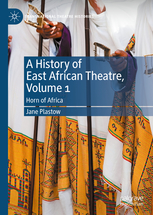A History of East African Theatre
 Author
Author
Year of Publication
2020
Description
Volume 1. This book is the first ever transnational theatre study of an African region. Covering nine nations in two volumes, the project covers a hundred years of theatre making across Burundi, Djibouti, Eritrea, Ethiopia, Kenya, Rwanda, Somalia, Tanzania, and Uganda. This volume focuses on the theatre of the Horn of Africa. The book shows how the theatres of Djibouti, Eritrea, Ethiopia, and Somalia, little known in the outside world, have been among the continent's most politically important, commercially successful, and widely popular; making work almost exclusively in local languages and utilizing hybrid forms that have privileged local cultural modes of production. A History of African Theatre is relevant to all who have interests in African cultures and their relationship to the history and politics of the East African region.
Volume 2. This second volume of A History of East African Theatre focuses on central East Africa; on Burundi, Kenya, Rwanda, Tanzania and Uganda. The first chapter is concerned with francophone theatres, comparatively studying work coming out of Burundi and Rwanda alongside a focus on French language theatre in Djibouti. The chapter is particularly concerned to explore how French and Belgian cultural policies impacted theatre during the colonial period and how the French ideas of Francafrique and promotion of elite, French language art have continued to resonate in the post-colonial present. Chapters Two and Three look comparatively at the rich theatre histories of Kenya, Tanzania and Uganda, and are divided between a study of British East African colonial impact and an analysis of the post-colonial period illustrating how divergent political thought and societal make-up led to exponential differentiation in national theatres. The final chapter, on Theatre for Development and related social action theatre, covers the whole East African region, offering the first ever historicised analysis of this mode of theatre making which, since the 1980s, has come to dominate funding and opportunity in performance arts.
